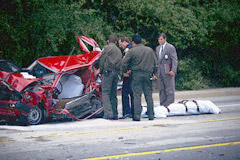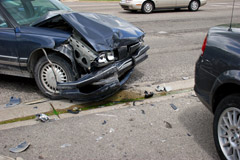Comprehensive Claims
Comprehensive claims are fire and theft claims. Insurance companies have been denying more claims for fire and theft in the last ten years. Insurance companies look at these claims very carefully. To discover if the owner of a car had a financial incentive to destroy his car, insurance companies will check the transmission fluid and oil in the car after a fire to determine if the car was in good working condition. Companies will also check the financial status of the insured to see if the owner of the car was having money problems. The companies’ intention is to show through circumstantial evidence that the owner of the car was motivated to destroy it himself.
 Cases involving a combination of a theft and fire of an automobile are generally referred to the Special Investigations Unit (SIU) of the insurance company. The SUI investigates possible fraudulent claims. The SIU may ask the insured to provide a sworn statement under oath. One of the purposes of a statement under oath is to put the insured on record so that his story can be checked in detail against facts developed by the company. Another purpose of the statement is to get the insured's version under oath. That permits the insurance company to threaten the insured with the possibility of perjury. On occasion, an SIU investigator will make statements or write letters accusing the insured of engaging in criminal activity. A statement that you have engaged in criminal activity is libel or slander (either oral or in writing) unless it is true. Libel and slander require a publication of the statement. That means that someone other than the person making the statement and the insured must have been made aware of the statement by the insurer. We handled a case against a national insurance company where we took the statement of the head of the Special Investigations Unit. He was in charge of all fraudulent claims investigated by that company for the territory east of the Mississippi River. During the ten years before his statement, his unit investigated an average of 200 potentially fraudulent claims per year. The only claim in which his unit wrote a letter to the insured saying that "you have engaged in fraud and we are not going to pay you" was to our client. The insurance company was wrong. They paid many times the amount of the loss in order to settle the claim because of their inappropriate claims handling and slanderous letters. Cases involving a combination of a theft and fire of an automobile are generally referred to the Special Investigations Unit (SIU) of the insurance company. The SUI investigates possible fraudulent claims. The SIU may ask the insured to provide a sworn statement under oath. One of the purposes of a statement under oath is to put the insured on record so that his story can be checked in detail against facts developed by the company. Another purpose of the statement is to get the insured's version under oath. That permits the insurance company to threaten the insured with the possibility of perjury. On occasion, an SIU investigator will make statements or write letters accusing the insured of engaging in criminal activity. A statement that you have engaged in criminal activity is libel or slander (either oral or in writing) unless it is true. Libel and slander require a publication of the statement. That means that someone other than the person making the statement and the insured must have been made aware of the statement by the insurer. We handled a case against a national insurance company where we took the statement of the head of the Special Investigations Unit. He was in charge of all fraudulent claims investigated by that company for the territory east of the Mississippi River. During the ten years before his statement, his unit investigated an average of 200 potentially fraudulent claims per year. The only claim in which his unit wrote a letter to the insured saying that "you have engaged in fraud and we are not going to pay you" was to our client. The insurance company was wrong. They paid many times the amount of the loss in order to settle the claim because of their inappropriate claims handling and slanderous letters.
If an SIU investigator asks to take your statement, you should consult an attorney. The Special Investigations Unit is not involved in your case unless the insurance company has determined that there is potential fraud involved in your claim. |
Uninsured/Underinsured Motorist Claims
An uninsured motorist claim is one where the person who caused the accident is not insured. Insurance policies can provide coverage for you and anyone in your car at the time of the accident if you are in a collision caused by an uninsured driver. In Pennsylvania, uninsured motorist coverage is optional. You must buy liability insurance to cover someone whom you might injure when driving your automobile. If you waive uninsured motorist coverage, you agree that if someone with no insurance injures you, you then have no insurance to compensate you for your injury.
 Underinsured motorist insurance covers the difference between the amount of damages sustained by the owner or occupant of a car, and the insurance coverage purchased by the driver who causes an accident. For example, if the driver who causes the accident has $15,000 worth of insurance and you suffer damages of $100,000, you could collect the $85,000 difference from the insurance company who insured the car you occupied at the time of the accident. You can recover up to the amount of coverage purchased by the owner of the car you occupied. Thereafter, you could recover under policies in your household. (See stacking below.) Underinsured motorist insurance covers the difference between the amount of damages sustained by the owner or occupant of a car, and the insurance coverage purchased by the driver who causes an accident. For example, if the driver who causes the accident has $15,000 worth of insurance and you suffer damages of $100,000, you could collect the $85,000 difference from the insurance company who insured the car you occupied at the time of the accident. You can recover up to the amount of coverage purchased by the owner of the car you occupied. Thereafter, you could recover under policies in your household. (See stacking below.)
Stacking
 “Stacking” means that all
policies in the household of the injured individual are added together. The combined limit would be available to pay the
insured individual after the initial limits on the responsible party's vehicle were exhausted. Insurance companies permit stacking
because the insurance company receives a premium on each car for the same coverage. If you own four automobiles, each of which was insured
for $100,000.00 of underinsured motorist coverage, you would have the potential to recover $400,000.00 from your own insurance company
($100,000.00 stacked four times). You must have purchased this option in order to have this coverage. “Stacking” means that all
policies in the household of the injured individual are added together. The combined limit would be available to pay the
insured individual after the initial limits on the responsible party's vehicle were exhausted. Insurance companies permit stacking
because the insurance company receives a premium on each car for the same coverage. If you own four automobiles, each of which was insured
for $100,000.00 of underinsured motorist coverage, you would have the potential to recover $400,000.00 from your own insurance company
($100,000.00 stacked four times). You must have purchased this option in order to have this coverage.
|
Bad faith - Uninsured or Underinsured Motorist Claim
Uninsured and underinsured motorist claims are first party claims or claims made by the injured against his own policy. Insurance companies deal with injury claims in an adversarial manner. Most claims made to an insurance company are from individuals claiming that the insured injured them. In the third party context, the insurance company has no specific duty to the third party other than abiding by rules and regulations set by the state. Those rules and regulations generally deal with the timing of investigations and a prohibition against acting fraudulently. A few states have extended their bad faith or insurance company malpractice statute to third parties. Pennsylvania is not one of them.
The exception is a situation where liability is clear and the damages sustained by the injured party exceed the insurance purchased by the insured negligent party. In a situation of that nature the insurance company would have an obligation to offer the policy limits. The basis for this obligation is to avoid placing the insured in a position where a trial will result in a verdict beyond the coverage purchased. Uninsured and underinsured motorist claims are first party claims or claims made by the insured against his own policy.
The general concept behind bad faith or insurance company malpractice is that the insurance carrier has an obligation to be fair and honest with its insured. This duty creates a conflict of interest for the adjuster, who is always trying to settle the case for the least amount of money. The cases dealing with bad faith indicate that the insurance company cannot place its own financial interests above the financial interests of the insured. A classic example arose when a client of ours told the insurance company that he only wanted what was fair and reasonable under the terms of his underinsured motorist coverage. The insurance company evaluated the claim as having a value of $3,750,000 out of the $4,000,000 available on a stacked policy. The insurance company then met with its insured and told him it was going to make him a fair and reasonable offer. Despite its own evaluation, the insurance company offered only $1,000,000. In effect, the insurance company was attempting to steal $2,750,000 from its own insured, since it had evaluated the case at $3,750,000. Ultimately, the insurance company paid not only the full $4,000,000.00 to the insured, but also additional money for its dishonest (bad faith) claim handling.
 Another area where a bad faith or insurance company malpractice can arise in an uninsured or underinsured motorist claim is on the liability aspects of the claim. All claims are divided into two issues. The first issue is liability. Liability comes down to the question of who is responsible for the accident or injury. The second issue of any claim is damages. Damages would be the appropriate compensation to make the injured party whole for all of the injuries sustained, both physical and economic. Another area where a bad faith or insurance company malpractice can arise in an uninsured or underinsured motorist claim is on the liability aspects of the claim. All claims are divided into two issues. The first issue is liability. Liability comes down to the question of who is responsible for the accident or injury. The second issue of any claim is damages. Damages would be the appropriate compensation to make the injured party whole for all of the injuries sustained, both physical and economic.
There are instances where an insurance company will defend an uninsured or underinsured motorist claim on the basis of a flawed liability theory. The flawed liability can deal with the actual occurrence of the accident. We represented a client who suffered brain damage in an accident and was unable to recall how the accident took place. The insurance company attempted to use the fact that the client could not remember what happened to its benefit by claiming that the Plaintiff (their insured) had the burden of proof. If we could not establish how the accident took place, we could not win the case because we could not prove it by a preponderance of the evidence. There was an eyewitness, however, to establish that the insured was not at fault for the accident. By ignoring the eyewitness, the insurance company put its own financial interests above those of the insured. Unless the insurance company had evidence that the witness was not present or lied about her observations, it had no basis for ignoring the information when evaluating liability. When that conduct was coupled with the magnitude of the injury and the limited amount of the insurance available, the insurance company’s conduct crossed the line of what is acceptable in claims handling and became bad faith or insurance company malpractice.
 A bad faith claim can also arise when an insurance company makes a determination that there is no coverage for a particular loss. If the coverage decision is both wrong and/or not investigated fully, it can amount to a bad faith. In such a case the insurance company would be responsible for the claim. In addition to the underlying claim, the insurance company could be responsible for a bad faith claim. In Pennsylvania the penalty for bad faith conduct can be attorney's fees, and/or interest from the time the claim was made, and/or punitive damages, and/or compensatory or consequential damages. We handled a case where an insurance company claimed that underinsured motorist coverage did not apply to our client, who was injured while on the job. The company stated that because the client was entitled to worker's compensation benefits, he could not make a claim for underinsured motorist coverage. Their position was that worker's compensation benefits are intended to be the exclusive remedy in claims against the employer. What the insurance company did not take into account was the fact that it had written a separate policy for underinsured motorist benefits from the worker’s compensation policy. Additionally, the law in Pennsylvania on the issue had been decided in favor of the ability to bring the underinsured motorist claim. Nonetheless, the company continued to maintain its position. At the same time that the company was claiming that our client could not make a claim for underinsured motorist benefits, it was claiming that the client owed them reimbursement of monies spent on his behalf in the worker's compensation claim. The net effect of the position of the insurance company was that it claimed to have the right to be paid by the insured, but the insured driver did not have the right to be paid by them. After the underinsured motorist claim was litigated successfully against the insurance company, it was forced to pay substantial damages for the bad faith claim handling involved in the underinsured motorist claim. A bad faith claim can also arise when an insurance company makes a determination that there is no coverage for a particular loss. If the coverage decision is both wrong and/or not investigated fully, it can amount to a bad faith. In such a case the insurance company would be responsible for the claim. In addition to the underlying claim, the insurance company could be responsible for a bad faith claim. In Pennsylvania the penalty for bad faith conduct can be attorney's fees, and/or interest from the time the claim was made, and/or punitive damages, and/or compensatory or consequential damages. We handled a case where an insurance company claimed that underinsured motorist coverage did not apply to our client, who was injured while on the job. The company stated that because the client was entitled to worker's compensation benefits, he could not make a claim for underinsured motorist coverage. Their position was that worker's compensation benefits are intended to be the exclusive remedy in claims against the employer. What the insurance company did not take into account was the fact that it had written a separate policy for underinsured motorist benefits from the worker’s compensation policy. Additionally, the law in Pennsylvania on the issue had been decided in favor of the ability to bring the underinsured motorist claim. Nonetheless, the company continued to maintain its position. At the same time that the company was claiming that our client could not make a claim for underinsured motorist benefits, it was claiming that the client owed them reimbursement of monies spent on his behalf in the worker's compensation claim. The net effect of the position of the insurance company was that it claimed to have the right to be paid by the insured, but the insured driver did not have the right to be paid by them. After the underinsured motorist claim was litigated successfully against the insurance company, it was forced to pay substantial damages for the bad faith claim handling involved in the underinsured motorist claim. |







